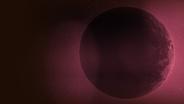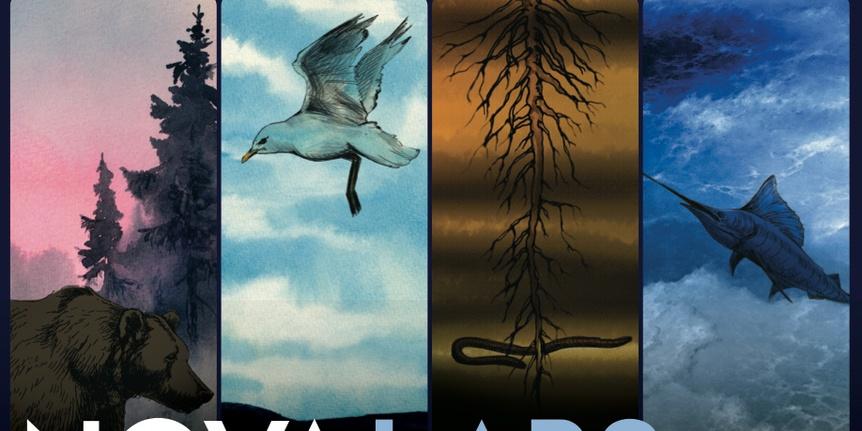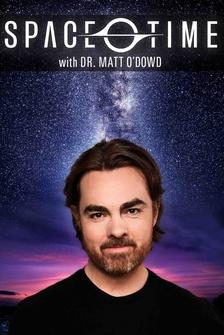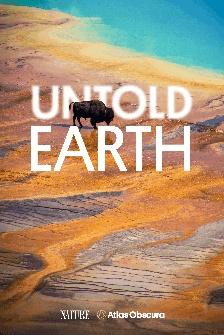NARRATOR: Hundreds of billions of stars in our galaxy.
And yet we know of only one that shines
on a life-filled planet.
Is Earth unique?
Or are there other solar systems and planets like ours...
out there?
Now, scientists are finding the answer.
Thanks to this:
The Kepler Space Telescope.
The most powerful planet hunter ever built.
It's making astonishing discoveries.
NATALIE BATALHA: The sheer numbers of planets out there
is really quite stupendous.
NARRATOR: From enormous gas giants...
to a land where the sun never sets...
to worlds that may be entirely covered in water.
Kepler is even finding planets like our own.
GEOFF MARCY: This might be the first Earth analogue
around a sun-like star that's ever been found.
NARRATOR: Scientists are beginning to wonder if those planets
could be inhabited.
And if so, by what?
ANDREW KNOLL: It's fun to speculate about life,
but any life is going to be subject to the laws
of chemistry and physics.
LEWIS DARTNELL: Even on another planet
we can work out how biology is likely to adapt.
NARRATOR: This is the story of how one spectacular spacecraft
has brought us closer than ever
to answering mankind's ultimate question:
Are we alone?
"Alien Planets Revealed," right now on NOVA.
Major funding for NOVA is provided by the following:
NARRATOR: The most ambitious planet-hunter ever built sits on a launch pad
at Cape Canaveral, Florida.
MAN: T minus five, four, three, two,
engines start, one, zero.
(loud explosion)
NARRATOR: Over two decades in the making,
it is about to radically alter what we know about our galaxy.
MAN (on radio): Running out of the solids.
Ready for separation.
NARRATOR: Meet the Kepler Space Telescope.
Its mission: to detect alien worlds orbiting distant stars.
And to discover if any of them could be a suitable home
for life as we know it.
Project scientist Natalie Batalha
has lived with the Kepler mission
from the very first moment.
BATALHA: To watch it launch was really quite something.
This feeling that after decades of planning
it was finally happening, it was going up there.
That was a tremendous moment.
NARRATOR: Launched in 2009, this incredible optical telescope
has revealed that planets are far more common
than we ever imagined.
GEOFF MARCY: What's amazing is not just the number of planets
that Kepler has found, but the types of planets.
NARRATOR: Of the 3,500 potential planets that Kepler has spotted,
some seem familiar.
Huge gas giants similar to Jupiter or Saturn,
or smaller, rocky worlds that could be like Earth,
Venus, Mars or Mercury.
But others are straight out of science fiction.
Like Kepler-16b, which orbits a double star.
Just like Luke Skywalker's home planet in Star Wars.
Even more bizarre is Kepler-10b.
It orbits so closely to its sun that the surface
is a vision of hell.
BATALHA: Kepler-10b is a scorched world.
It's got an ocean
bigger than the Pacific Ocean,
but it's an ocean not of water but of molten lava.
That star-facing side as it orbits
has surface temperatures in excess of that required
to melt iron.
So this is a blow-torched world.
NARRATOR: But for Kepler, these oddities are just a sideshow,
because its primary mission is to find a planet
that might have the right conditions for alien life--
a planet like Earth.
Now, Kepler might be closing in on just such a world.
The Kepler data suggests that potentially habitable planets
are out there.
And applying the principles of biology and evolution,
scientists are even beginning to guess how ETs
could have adapted to their environments.
KNOLL: The best speculation recognizes that there are rules
to the game.
Any life that we can contemplate is going to be subject
to the laws of chemistry and physics.
MARCY: Kepler is finding worlds
that, as far as we can tell, have the right environment,
the correct temperatures
suitable for life as we know it.
NARRATOR: Kepler is unique among space telescopes.
Unlike the Hubble, which turned its gaze far and wide
and sent back stunning images of the cosmos,
Kepler is designed to stare fixedly
at one small patch of sky, taking the same snapshot
day in and day out for years on end.
It began-- as with any new telescope--
with what astronomers call "First Light."
BATALHA: Kepler's first light image came down to us at NASA Ames
about 24 hours after we ejected the disc cover.
As it filled my computer screen, the image that came to my mind
was like champagne filling a glass
with all of these stars being the little bubbles.
It was very exciting.
Every single tiny dot that you see is a star
that is in the field of view of Kepler.
NARRATOR: Kepler is focused on a small patch of sky
near the constellation of Cygnus the swan.
BATALHA: In that area of sky are four and a half million stars
in our galaxy alone.
NARRATOR: But Kepler isn't looking for stars.
It's looking for planets that orbit the stars.
But that's a problem,
because Kepler can't directly see planets.
Planets are much smaller and dimmer than stars.
They get lost in the glare.
So Kepler is looking for something called a transit,
which occurs when a planet passes in front of the star.
As it does so, it dims the light by a fraction.
That dimming is what Kepler is designed to detect.
It's a principle that can be illustrated
with a distant tower and a spotlight.
Okay, let's imagine that there's a moth flying
around that spotlight.
Could we ever hope to see the moth?
No way.
The moth-- although it does reflect a tiny bit
of the spotlight's light-- it's far too feeble
for us to see that.
NARRATOR: Since the light reflected
off a planet is typically ten billion times fainter
than the light emitted by its star,
detecting a planet might seem impossible.
But Kepler has a way around that problem.
If the moth passes in front of the bright light,
a little bit of the light that was going to reach us
obviously gets blocked by the moth.
Then we are able to detect the moth
by measuring very carefully that very subtle change
in the total brightness of the spotlight.
NARRATOR: The bigger the moth, the more light it blocks,
and the more the light dims.
CHARBONNEAU: In exactly the same fashion, that's how we can detect
small planets orbiting other stars
and even measure their sizes.
NARRATOR: That's Kepler's primary mission:
to watch thousands of stars for signs of a transit.
Scientists plot the brightness of each star in Kepler's view
on a graph to see how it changes over time.
This is an actual plot of one star over two weeks.
Sure enough, every three days
there's a tiny dip in brightness,
revealing a planet orbiting this star once every three days.
Just like the moth, the bigger the planet,
the more light it blocks.
In this plot, a huge planet transits in front of its star
causing a much larger dip.
Right from the start, Kepler saw stars dimming.
By June 2010, 15 months after launch,
Kepler had found over 700 potential planets.
BATALHA: The sheer numbers of planets out there
is really quite stupendous.
Here you see just a small sample of them.
And the planets range in size
from, you know, a half radius of the Earth,
up to things that are several times larger than Jupiter.
NARRATOR: Already, Kepler's discoveries are changing what we know
about alien planets.
SARA SEAGER: Kepler has revolutionized our view of planets
and planetary systems in our galaxy.
It turns out that any kind of planet is possible,
within the laws of physics and chemistry.
Any planet you can conceive of can exist in any location
in a planetary system.
NARRATOR: Extrapolating from the Kepler data,
some estimates put the number of planets in the universe
in the trillions.
But what everyone really wants to know
is do any of these planets have life?
To answer that, we have to go back to the basics
and ask, is the universe full of the same stuff everywhere?
Are the elements needed for life as we know it
commonplace?
The lightest elements-- hydrogen and helium--
were made in the moments after the Big Bang.
Other elements are made in stars--
a product of nuclear fusion during the star's
normal life cycle--
or produced when some stars explode as supernovas,
scattering these essential building blocks into space.
KNOLL: Every molecule in your body, every element in your body,
was generated some time in the distant past,
by processes within stars.
NARRATOR: Among the most common are the elements
that are essential to all living things on Earth:
hydrogen, oxygen,
carbon and nitrogen.
Life could be anywhere or everywhere in our galaxy,
but where should we look?
Since planets are proving to be so abundant,
Chris McKay thinks we might as well search for life
that follows rules we already understand.
McKAY: I know how to search for organic material.
I know what the signatures that would be important are.
So the search for life starts off following water,
following carbon.
Not because we can prove that that's the only way to do it,
but because that's the only way we know how to do it.
NARRATOR: Sifting through the Kepler data,
scientists have made a deliberate decision:
to look for planets that resemble the one place
they know can sustain life...
the Earth.
MARCY: We know that the Earth
is habitable; indeed, inhabited.
And so surely, there's some drive to find
another Earth-like planet elsewhere in the universe.
BATALHA: Humanity is on a quest to find life.
Kepler's objective is first to find out
if planets like Earth--
where we have this one example of life--
if planets like that exist.
NARRATOR: Earth, as we know, is teeming with life.
Organisms have evolved to exploit every niche.
From the beneath the waves...
to the highest mountains.
So what's so special about our pale blue world?
For most scientists, the key feature of Earth
is the presence of liquid water on its surface.
Chris McKay has spent years studying the relationship
between life and water.
McKAY: The question is, can life survive without water?
This is the place to find the answer to that question.
This is the desert.
NARRATOR: In this baked dry sand near the Mojave Desert in California,
Chris is looking for critters that can live without water.
One possible candidate are these small black patches,
which are in fact alive.
McKAY: It looks like a black flat rock,
but in fact, it's a layer of photosynthetic microorganisms.
NARRATOR: But Chris has discovered that although they look bone-dry,
they actually require water.
McKAY: The microorganisms have solved
the problem of the lack of water in a very ingenious way.
The organisms secrete organic materials,
which help to hold water.
They make little super sponges,
and so the rare moisture that's there, they can hold it.
They can hold it longer than in normal sand.
These organisms have created a little tiny micro habitat
in which they live.
NARRATOR: Chris has studied organisms across the Earth:
in the dry valleys of Antarctica
and in the Atacama Desert in Chile,
the driest desert in the world.
And everywhere, he's found life using
similar survival strategies.
We have never found an organism on Earth...
the driest, coldest places,
and we've looked-- and boy, have we looked--
we've never found an organism
that can make do without liquid water.
NARRATOR: So life as we know it needs liquid water.
Fortunately, water is made
of two of the most abundant elements in the universe:
hydrogen and oxygen.
We've even detected water vapor in clouds of gas
in outer space.
What's harder to find is a planet that could have
liquid water--
where the temperature is warm enough to melt ice
and yet below the point where water boils to steam.
McKAY: The sun is like a fire.
It provides light and to that light, warmth.
And that warmth is what keeps a planet warm enough
to support liquid water.
If it's too far from the sun, the water will be ice.
If it's too close, the water will be steam.
So it needs to be right in that zone
where the water can be liquid.
Sometimes we call it the "Goldilocks zone."
It's not too hot, it's not too cold,
it's just right.
NARRATOR: Kepler's core mission
is to find Earth-size planets in the Goldilocks zone.
Remarkably this data that shows the timing of each transit
is also the key to finding out how hot a planet might be.
The more frequent the planet transits,
the hotter it is.
McKAY: When a planet is very close to the star,
it's going around quite rapidly.
The period is very short-- can go around in weeks, even--
around the central star.
As a planet is further away, it takes much longer.
NARRATOR: A planet that orbits once a week
will be close to its star and very hot.
A planet that orbits every ten years
will be very far away and too cold.
So scientists were looking for a planet orbiting
a Sun-like star roughly once a year, like Earth.
On May 12, 2009, just three days
after the spacecraft started collecting data,
it saw the light from the star Kepler-22
dim ever so slightly.
Ten months later, it dimmed again.
If it happened once more in another ten months,
it would confirm Kepler was seeing a transit.
Sure enough, on December 15, 2010,
the star dimmed once more.
Kepler had discovered its first planet
in the habitable zone:
Kepler-22b, over 600 light-years away.
BATALHA: Kepler-22b was the first confirmation
of a planet that is at just the right temperature,
so it's in the Goldilocks zone.
It's orbiting a star very much like our own Sun.
NARRATOR: The researchers can use the amount of dimming
to measure the size of the planet.
It works out at about 2.4 times the radius of Earth.
So now comes the next mystery.
What kind of planet is Kepler-22b?
What is it made of?
The key to a planet's composition is its size.
When planets form they start off solid,
made of rock and ice.
If they become big enough, they're able to hold on
to huge amounts of gas--
hydrogen and helium the most abundant.
These become the gas giants, like Jupiter and Neptune.
Smaller planets like Earth are primarily rocky
and can only hold on to a thin atmosphere.
Kepler-22b is in the middle,
bigger than all the rocky planets in our system,
but smaller than the gas giants.
So is it mainly gas or rock?
Astronomer Geoff Marcy is attempting to find out.
Tonight, he's using the Keck Telescope in Hawaii,
which he's operating via video link from Berkeley, California,
over 2,000 miles away.
MAN (on screen): So Geoff, I just opened up and did an autofocus.
We've got about .85 parts...
That's great, fantastic.
And we're set up and ready to go on your first target.
Tonight we're going to be observing Kepler-22b,
the planet which is still somewhat mysterious.
We don't know whether the planet is rocky, like the Earth,
or gaseous, like Jupiter and Saturn.
NARRATOR: To answer this question, Geoff is using
a very different way of detecting planets.
Nicknamed the wobble method, this technique was used
to find some of the first exoplanets,
and it's also used to find out more
about the planets discovered by Kepler.
MARCY: We can detect planets around other stars,
even without seeing the planets, by watching the star.
Let's create a star.
And, of course,
we'd like a planet orbiting that star.
Now what's interesting is that the planet
not only orbits the star, but the star is yanked on
gravitationally by the planet.
So we see the star wobble around,
and we can detect this with our telescopes here on Earth.
NARRATOR: The Keck Telescope can see if a star is wobbling
backwards and forwards in response to a planet
we can't actually see.
But even more beautifully, we can measure
the mass of the planet,
because the more massive the planet orbiting the star,
the more violently that star is yanked on gravitationally.
NARRATOR: If the telescope detects a large wobble,
it means a massive planet is orbiting the star.
MARCY: We're heading to the Kepler field now.
So I'm going to set the exposure meter...
NARRATOR: Geoff takes aim at Kepler-22.
...so that gives us Doppler shift precision
of about 1.5 meters per second.
So we'll be able to measure the speed of the star
to within plus or minus human walking speed.
Here we go.
And there it is, Kepler-22; looks beautiful.
NARRATOR: Even with this high level of precision,
Geoff fails to find a measurable wobble,
which means that the planet is not extremely massive.
MARCY: So far what we can tell
is that the planet is probably not purely solid;
it's not a big ball of rock.
NARRATOR: Kepler-22B could still be a gas world,
a kind of mini Neptune.
But there's another possibility that's even more intriguing.
This planet might be unlike anything in our solar system:
a water world.
SEAGER: We do know that as long as the planet
is over seven times the Earth's mass,
it could possibly have liquid water in its surface.
So Kepler-22b, despite being a relatively big planet,
is still in the potentially habitable category.
MARCY: From the study of other planets,
all of those somewhat larger than Earth planets
have lots of water and also, perhaps, some atmosphere.
So, by association, the bet is that Kepler-22b
will be a rocky planet with a very dense and thick ocean.
NARRATOR: If Geoff is right, this would be a planet
completely covered in water.
It's the perfect planet for a paddle.
Geoff can imagine what it would be like to kayak
on Kepler-22b.
If you were kayaking on Kepler-22b,
you'd look overhead and you'd see a host star
that would remind you of our own Sun here,
a yellowish star, about the same size as our Sun.
The gravity of the planet might be a little higher
or a little lower than the Earth,
but not so different.
NARRATOR: But look beneath the surface
and this ocean is unlike anything on Earth.
MARCY: The ocean would be
thousands of kilometers thick.
There would be no ocean floor to dive down and visit
because it would simply be too far away.
NARRATOR: Kepler-22b could have all the ingredients for Earth-like life.
Energy is plentiful in sunlight from the nearby star.
The necessary elements like hydrogen, oxygen, carbon
and nitrogen are commonplace throughout the galaxy.
But for life to occur, these elements would have
to form into a molecule with a very special property,
a molecule that can self-replicate like DNA.
KNOLL: Life is a chemical system capable of Darwinian evolution.
We need molecules for life that contain information.
We need molecules that can mutate
so that that information changes and that can be inherited.
I suspect that carbon is going to be the stuff of life
and there will be information containing molecules
such as DNA.
NARRATOR: Even here on Earth we don't know how DNA first came to exist.
But even if the creation
of a molecule that works like DNA is unlikely,
life may have sheer numbers on its side.
KNOLL: It may be that only one planet in a million
will give rise to life, but on the basis of Kepler,
some people have suggested that there might be
ten to the 19th planets in our galaxy
or in nearby galaxies.
That's a very big number.
And so the probability that life exists elsewhere
is pretty high.
NARRATOR: It's this emerging statistical fact
that leads many scientists to be confident
that extraterrestrial life does exist.
SEAGER: Is there life elsewhere?
Well, our galaxy alone has 100 billion stars.
NARRATOR: If DNA-- or a similar self-replicating molecule--
has formed on any of those planets,
life could have been around for some time.
KNOLL: If we go back to the very oldest sedimentary rocks on our planet
and look for the signature of life, it's already there.
And that tells us that life arose early.
NARRATOR: But early life was limited to simple, single-celled organisms.
Microbes had the Earth to themselves for billions of years
before complex life evolved.
It may be that microbes rule our galaxy as well.
The most probable life on other planets
would be something much more similar to bacteria
than to you or me.
NARRATOR: Of course, we don't know how likely it is
that complex life would evolve on an alien world.
It's still very much an open question
as to whether life could get started on such a water world,
but over billions of years, if the climate is stable enough,
evolution will have had the chance
to get beyond microbial life
to forests of complex, advanced trees.
NARRATOR: Could plants adapt to life in an endless ocean?
DARTNELL: On a water world,
the main challenge these plants are going to face
is remaining buoyant; you can't start sinking down.
You want to float, perhaps by having bladders filled with gas
that help you to buoy up in the water.
NARRATOR: While scientists can speculate about life on Kepler-22B,
for now, there is no way to confirm
that there is water on its surface.
Fortunately, it isn't the only potential life-supporting planet
Kepler has found.
On February 28, 2012, nearly three years after launch,
NASA announced over 1,000 potential new planets.
One of these was orbiting the star KOI 2626.
This potential planet
is about one and a half times the size of Earth,
small enough that it's likely to be rocky.
But there's a problem:
it doesn't orbit a star like our Sun.
It orbits a very different kind of star.
When I was a kid,
I was told in school that the Sun is an average star,
which is a complete lie.
The Sun is not an average star.
Most stars in the galaxy are much less massive
and put out much less energy than the Sun.
And we call these very low-mass stars M-dwarfs.
Our Sun is yellow in color, very massive, very large,
and compared to it, these low mass M-Dwarf stars are tiny.
They are only about 10% or 20% the size,
10% or 20% the mass,
and they only put out 1/1,000th the amount of energy.
NARRATOR: M-dwarf stars, also known as red dwarfs,
make up over three quarters of all stars in the universe.
Because the star is so small,
it's easier to spot a small planet orbiting one.
Even though an Earth-sized planet
covers only about 0.1% of a red dwarf,
it typically dims the light by an easy-to-see one percent.
Dave Charbonneau and his team
have searched through the Kepler data
and they've found that more than half of all such stars
have planets Earth-sized or a little larger.
But could a planet orbiting such a dim star
be warm enough to have oceans of water and even life?
An M-type star provides much less sunlight than our star.
To get the same amount of warmth,
just like this dimmer fire, you have to move in closer.
There's still a habitable zone:
you can get close enough to the star
that it's warm enough for liquid water.
NARRATOR: KOI 2626.01 orbits its red dwarf star once every 38 days.
But being so near to a star can create a strange situation.
Gravity from the star pulls more strongly
on the closest side of the planet:
a slight drag that can cause one side
to always face the star.
Astronomers call this tidal locking.
This alien world would have a light side
on which the sun never sets,
and a dark side on which the sun never rises.
At first, scientists thought
that this would make the planet impossible for life
because it wouldn't have an atmosphere.
When we first conceived of the notion
of a tidally locked planet, even in the habitable zone,
the thought was, "Well, on the dark side,
"it's going to be very, very cold,
"so cold that the atmosphere could condense out completely.
"All the carbon dioxide
"that would normally be in the atmosphere
"would be present as ice,
forming a giant polar cap on the dark side."
Ice like this.
This is a chunk of carbon dioxide.
NARRATOR: But atmosphere expert Kevin Heng wasn't so sure.
He builds computer simulations of alien atmospheres.
He's a kind of interplanetary weather forecaster.
Heng used what we know about the red dwarf planet
to simulate the atmosphere.
And this is what he came up with:
a map of the whole planet laid out flat,
the colors representing the predicted temperature.
KEVIN HENG: What you're seeing
is a temperature map near the surface.
Right in the middle of the map
is the point where the temperatures
are expected to be the highest.
NARRATOR: And this temperature difference
between the hot side and cold side
has a profound effect on the atmosphere.
Here on the dark side, the air cools and sinks,
spreading out around the planet.
That creates a wind
that blows along the surface to the hot side.
Here, the air heats up and rises
before returning to the cold side.
So if this planet has an atmosphere,
it would have a permanent, planet-wide wind system.
This reduces the temperature difference
and keeps the atmosphere from freezing,
which means that the planet might be habitable after all
with a stable atmosphere
and in some places, a pleasant climate.
HENG: You probably want to live close
to where the day side transitions into the night side,
the so-called day/night terminator.
Temperatures are between 10 and 20 degrees Celsius.
So a good spot for real estate.
NARRATOR: If there is plant life here,
it would have to adapt to an endless deep red sunset.
Here on Earth, most plants capture energy with chlorophyll,
a green pigment adapted to harness
the yellow light from our Sun.
But on a red dwarf planet with its red light,
an alien plant-like species
might adapt to produce different pigments.
Nancy Kiang is trying to work out
what those alien plants could be like.
One clue is to be found in the marshes of New England.
The sandy areas you might think
are just dead areas with no plants,
but actually there's life teeming underneath.
NARRATOR: Living in the sand are layers of photosynthesizing bacteria.
What we see here are different kinds of bacteria
that are photosynthetic.
Each layer has different pigments
that absorb different wavelengths of light.
NARRATOR: The bacteria in the top layer are green.
They use the same chlorophyll that plants do
because they receive the full spectrum of sunlight.
But many of those frequencies get absorbed,
leaving the lower layers with a different color of light.
So they have evolved new photosynthesizing molecules
adapted to that different spectrum.
Studying these different molecules allows Nancy
to imagine what sort of pigments would work best on alien worlds
bathed in the dim red light of a red dwarf.
It leads to an intriguing suggestion.
KIANG: Very likely, these plants will try to absorb
as much visible light as they can.
So these plants to our eye might look black.
NARRATOR: Black because the plants
would need to absorb as much energy as possible
from the weak sun.
DARTNELL: Plants might find the situation actually easier to contend with
because the sun isn't moving through the sky.
You can just point yourself like a solar panel towards the sun.
But one of the other features of a tidally locked planet
would be the fearsome winds
blowing constantly in the same direction.
So maybe a flat panel
wouldn't actually end up being the optimal design
and you want to be a bit more flexible and giving
to allow the wind
to kind of blow through your perhaps fan-like shape.
NARRATOR: If there are plants,
could there also be alien animals on this planet?
From the wide variety of creatures that exist on Earth,
we know that many seemingly bizarre creatures are possible.
KNOLL: It's fun to speculate
about what life might look like on another planet,
and I think it's legitimate science
insofar as it tells us that there are rules to the game.
Any life is going to be subject
to the laws of chemistry and physics.
NARRATOR: Based on what we know about life on our world
and from what we know about the environment
on this distant planet,
scientists are beginning to imagine
what alien animal life might look like.
DARTNELL: On Earth, we find filter feeders:
life that filters particles or little grains of food
out of the water as it wafts past them.
On a planet like this,
we might find a similar strategy on the land.
So maybe we'd find something like land whales
that aren't filtering out plankton from the sea
like the whales in our oceans,
but are great big static animals that try to filter out
particle matter from the wind to feed off.
(roaring)
NARRATOR: Even though scientists speculate about how life might survive
on truly alien worlds like this,
most still believe that
our best hope of finding life that we might recognize
lies in finding a rocky planet a similar size to Earth
that orbits a sun more like our own.
It's a challenge of astronomical proportions.
BATALHA: A planet as tiny as an Earth
transiting across the disc of its star
is going to produce a change in brightness
of just one part per 10,000.
Imagine the tallest hotel in New York City,
and everybody has their light on,
and one person in this hotel
lowers the blinds by about two centimeters.
That's the change in brightness that we are trying to detect
from the transit of a planet as small as an Earth
passing in front of a star the size of our Sun.
NARRATOR: So Kepler scientists scour the data
for signs of a truly tiny dip:
evidence of an Earth-like planet.
And they find something promising
around star KOI 701, 1,200 light-years away.
The Keck Telescope confirms that
there are at least three planets orbiting the star.
MARCY: The third planet out,
that planet is in the habitable zone.
But it's also large, like 22b.
It's like Kepler-22b, probably a water world.
NARRATOR: The team was about to go public
when something extraordinary happened.
BATALHA: So 701.03 was done--
in the bag, nice ribbon tied around it,
ready to go off to the publisher for publication--
when we got an email from one of our team members
telling us that he had spotted what looks to be
another interesting signal in the data.
NARRATOR: What Natalie's team member had spotted at the last moment
could turn out to be
one of Kepler's most exciting discoveries.
It looked like KOI 701
didn't just have three planets orbiting it.
There were four.
And this new potential planet
was in the right place and the right size.
MARCY: We examined the data more carefully,
and there is another planet that is smack in the habitable zone,
and it's only a little bigger than the Earth.
NARRATOR: It was exactly what Kepler had been searching for:
a planet in the habitable zone,
small enough that it could be made of water and rock,
like the Earth.
And so this is something you could stand on,
something that is rocky.
MARCY: This might be the first truly Earth analogue
around a Sun-like star that's ever been found.
NARRATOR: The planet, today confirmed as Kepler-62f,
is over 1,200 light-years away.
Even our fastest spacecraft
would take many millions of years to reach it.
But this could be the most Earth-like world
Kepler has found.
MARCY: And that's the amazing planet
that has the hairs standing up on the back of my neck.
NARRATOR: If this planet has oceans of water and rocky land masses,
then the possibilities for life here
could be as numerous as they are on our own planet.
KNOLL: On our planet,
we began with simple bacteria,
and today, we have a planet that has ten million species
of animals, plants, fungi, kelps, all sorts of things.
NARRATOR: In the oceans, the environment could be
surprisingly similar to that on Earth.
The density and properties of water are dictated
by the laws of physics, which are universal.
DARTNELL: What we might expect is
for the aquatic or marine life to be actually pretty similar,
pretty familiar to what we know on Earth,
because the main consideration is being able
to move through the water as efficiently as possible.
So you want to be hydrodynamic,
you want to be streamlined in your shape.
And a very good streamlined shape is known as fusiform:
you'd be kind of bullet shaped, just like most fish on Earth.
NARRATOR: This ocean could be home to a complex ecosystem
with different sizes of organism
filling different ecological niches.
But because this planet is 40% larger than Earth,
it's likely to have stronger gravity.
So what might we find on land?
DARTNELL: Animals will respond
to the increased gravitational pull on a larger planet,
and so they would want to have body plans
which are also very strong,
so with column-like legs to support their increased weight.
NARRATOR: On Earth, all vertebrates have a maximum of four legs
because all animals with a backbone
evolved from a fish that had four fleshy, lobed fins.
But could aliens have more legs?
That's what Bill Sellers wants to find out.
He usually looks at extinct species like dinosaurs
by recreating their structure in a computer.
The same technique can be applied to an alien body plan.
SELLERS: When we have an alien life form,
we treat the shape of the animal as the framework of the robot.
We add motors to actually drive the creature,
and then the trick is that we get the computer to learn
how to be the most effective driver
for this particular shaped animal.
NARRATOR: Bill is investigating
how life might move in a high-gravity environment.
The computer model he's using is called a genetic algorithm.
First, he creates an eight-legged alien.
Then, the computer generates
hundreds of random movement patterns and tests them out.
SELLERS: This is a moving forward start, but as you can see,
what happens if it gets the pattern wrong,
then although it's still moving its legs,
it's lost all forward velocity,
and actually it's starting to go backwards
in a very unstable way.
Other examples of failures, for example, this one,
what happens is the front pair of legs trip over
and then the whole thing nose-dives
and because of where the weight is,
the back legs are up in the air and spinning round.
So again, this is a complete failure,
and we wouldn't work from those.
NARRATOR: But the computer can take the best of those random patterns
and combine them to produce new variations.
It echoes the process of natural selection that drives evolution.
SELLERS: After the evolutionary process is finished,
we end up with these very stable, very efficient gaits.
What the work has shown is that this eight-legged creature
mechanically could cope with higher gravity.
NARRATOR: Bill's work shows that
it is mechanically plausible that this new Earth-like planet
could have animals with eight legs walking across its surface.
If this planet does have complex animals,
could it also have intelligent life?
For astronomer Geoff Marcy, this is the ultimate question.
MARCY: We really don't know.
First of all, we don't know how commonly life gets kick-started.
And secondly, we don't know how commonly it evolves
into intelligent life.
NARRATOR: The probability of intelligent life evolving on another planet
is perhaps the greatest unanswered question.
But there are hints on Earth
that intelligence might be the exception, not the rule.
Sharks like the ones we see here
have ruled the seas for 400 million years,
and yet their brains are no larger than peas.
How could it be that after 400 million years,
sharks have not developed a higher intelligence?
And of course the answer must be
that high-IQ sharks compete no more successfully
than the less-intelligent sharks among us,
and that tells us something frightening
about life elsewhere in the universe:
perhaps the intelligence of which we humans are so proud
is not an attribute that is strongly favored
in Darwinian evolution.
NARRATOR: If Geoff is right, human intelligence may be the result
of a very unusual set of circumstances
that just happened to make our ancestors develop bigger brains.
But others, like Sara Seager, are more optimistic.
SEAGER: It's a tough call about whether or not there's intelligent life
around any of the nearest stars.
I believe there is intelligent life out there
somewhere in the galaxy
and that a future generation may be able to establish contact.
NARRATOR: While the chances of intelligent life evolving may be small,
the number of places it could be is huge.
BATALHA: About 900 of these planet candidates
are twice the Earth's radius or smaller.
So what this collection
of exoplanet candidates is telling us
is that small planets, planets like Earth,
might be common.
NARRATOR: Based on the Kepler data, scientists estimate
that at least one in six stars has an Earth-sized planet.
There could be upwards
of 17 billion Earth-sized planets in our galaxy alone.
Well, we are at a remarkable moment, actually.
The Kepler Space Telescope
has identified several thousand planets.
But what's unexpected and remarkable
is that we're finding planets
that are a little bit larger than the Earth
that as far as we can tell have the correct composition--
rock and water-- suitable for life as we know it.
NARRATOR: Kepler has shown us how commonplace
NARRATOR: Kepler has shown us how commonplace
planets outside our solar system are,
suggesting our galaxy
may have other places suitable for life.
Kepler continued to collect data until May 2013,
when the guidance system failed,
and it lost its steady lock
on the stars it had watched so keenly.
But the hunt for alien planets is far from over.
Kepler may have a second life,
using pressure from sunlight to keep it oriented.
And in coming years, new planet hunters will take up the quest,
exploring the age-old question: "Are we alone?"
The exploration continues on NOVA's website.
This NOVA program is available on DVD.
To order, visit shoppbs.org, or call 1-800-playpbs.
NOVA is also available for download on iTunes.
Captioned by Media Access Group at WGBH access.wgbh.org














